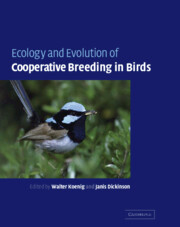Book contents
- Frontmatter
- Contents
- List of contributors
- Introduction
- 1 Evolutionary origins
- 2 Delayed dispersal
- 3 Fitness consequences of helping
- 4 Parental care, load-lightening, and costs
- 5 Mating systems and sexual conflict
- 6 Sex-ratio manipulation
- 7 Physiological ecology
- 8 Endocrinology
- 9 Incest and incest avoidance
- 10 Reproductive skew
- 11 Joint laying systems
- 12 Conservation biology
- 13 Mammals: comparisons and contrasts
- 14 Summary
- Names of bird and mammal species mentioned in the text
- References
- Taxonomic index
- Subject index
14 - Summary
Published online by Cambridge University Press: 02 December 2009
- Frontmatter
- Contents
- List of contributors
- Introduction
- 1 Evolutionary origins
- 2 Delayed dispersal
- 3 Fitness consequences of helping
- 4 Parental care, load-lightening, and costs
- 5 Mating systems and sexual conflict
- 6 Sex-ratio manipulation
- 7 Physiological ecology
- 8 Endocrinology
- 9 Incest and incest avoidance
- 10 Reproductive skew
- 11 Joint laying systems
- 12 Conservation biology
- 13 Mammals: comparisons and contrasts
- 14 Summary
- Names of bird and mammal species mentioned in the text
- References
- Taxonomic index
- Subject index
Summary
The existence of avian species in which social groups consist of more than a reproductive pair and individuals other than the parents feed offspring has been known for more than a century (Boland and Cockburn 2002), and active research on cooperatively breeding species has been ongoing since Skutch (1961) reviewed the important questions raised by such systems. Both the theoretical approach to evolutionary questions raised by cooperative breeding and the empirical investigation of such systems have changed greatly in these 40 years. In the first compilation of articles focused on cooperative breeding in birds Stacey and Koenig (1990a) presented summary chapters on long-term studies of cooperatively breeding birds, including several of the best-known species at the time. Research on those species yielded many of the data on which the theoretical foundation for our understanding of the evolution of cooperative breeding has been built.
The focus of Stacey and Koenig (1990a) on long-term behavioral and ecological studies was relevant because of the importance of such studies to identifying the costs and benefits of individual behaviors. Although the importance of long-term studies is no less significant today, it is also the case that with the advent of new techniques (particularly paternity analysis, phylogenetic methods, comparative analysis, and theoretical approaches such as reproductive skew theory), a questions-based approach to cooperative breeding has flourished and is reflected in the focus of this volume, in which conceptual issues relevant to the biology of all cooperatively breeding species, both birds and mammals, are examined.
- Type
- Chapter
- Information
- Ecology and Evolution of Cooperative Breeding in Birds , pp. 228 - 238Publisher: Cambridge University PressPrint publication year: 2004
- 11
- Cited by

